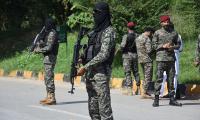ISLAMABAD: The latest Population Census for 2023 reveals that Balochistan recorded the highest population growth rate of 3.2 percent while Khyber Pakhtunkhwa (KP) witnessed the lowest rate of 2.38 percent.
The detailed Census Report 2023 released by the Pakistan Bureau of Statistics shows that the average annual growth rate of the population in Pakistan was 2.45 percent in 1961, it had an increasing and decreasing pattern over the years, gradually increasing to 3.69 percent in 1972 and decreased to 3.06 percent in 1981 and became 2.55 percent in 2023.
The current growth rate is the highest in the region and in the world. Ranking in terms Population Growth Rate, Pakistan Stands at 191, only 27 countries, mostly of Sub Saharan Africa, have growth rates higher than Pakistan. If this growth rate persists, the country’s population will be doubled by 2050. The highest population growth is evident in Balochistan with 3.2 percent while it is the lowest in KP with 2.38 percent.
According to the latest census, the total enumerated population is 241,499,431. In the country’s first census in 1951, the population was 33,740,167 that has increased more than seven times in the last 77 years and stands at 241,499,431 in 2023.
Punjab has the highest share with 52.9 percent in 2023, however it is continuously decreasing since 1951. Balochistan has the lowest share of population among the provinces, however, it is continuously increasing since 1951 from 3.5 percent to 6.2 percent in 2023. Similarly, though smallest by area, the share of population of Islamabad, the federal capital, is also increasing.
From 2017 to 2023, the highest percentage increase is 20.75 in Balochistan and the lowest change is 15.08 in Khyber Pakhtunkhwa.
It was observed that with the rapid increase in population, its density was constantly increasing from 42.4 person per sq km in 1951 to 303.4 person per square km in 2023. Highest density (2,609.1 per square kilometer) is observed in Islamabad showing the patterns of growth of federal capital, followed by Punjab with 622 persons per square km while the lowest is in Balochistan with 42.9 per square kilometer.
Karachi Division in Sindh emerges as the most densely populated, with a density of 5,779, followed by the Federal Capital Islamabad with 2,609 persons per square km. Lahore Division in Punjab and Mardan Division in Khyber Pakhtunkhwa exhibit the highest population density with 1,942 and 1,461 persons per square km, respectively.
However, in Balochistan, majority divisions are less populated as compared to area. Rakhshan, Kalat, Zhob, Mekran and Sibi, are thinly populated with density per km ranging from 11 to 38, emphasising the province’s vast and varied terrain. This data provides a concise overview of the distribution and density of Pakistan’s population, offering valuable insights into regional demographic patterns.
Among all the districts, the biggest is Karachi Central with the highest population density followed by Korangi. On the other hand, districts Awaran and Chagai with 6 persons, Washuk with 9 persons, Kharan with 17 persons and Zhob with 22 persons per sq km have the lowest density in the whole country.
In Punjab, cities like Lahore, Gujranwala, Faisalabad, Sialkot and Multan exhibit high population densities at 7,339, 1,645, 1,550, 1,492, and 1,441, persons per km respectively. In contrast, districts such as Bahawalpur, Rajanpur, Khushab, Bhakkar, and Chakwal show lower population densities at 173, 193, 231, 240, and 266 persons per sq km respectively.
The federal capital, Islamabad, stands out with a substantially high population density of 2,609 persons per sq km, reflecting the rapidly increasing population. This district-wise analysis provides a comprehensive overview of the demographic patterns in Punjab and Islamabad, essential for informed policymaking and development planning.
In Sindh, all districts of Karachi being the economic hub are densely populated. Karachi Central has the highest density with 55,396 persons per sq km, followed by Korangi, Karachi East, Karachi South and Karachi West, with population densities of 28,972, 28,214, 19,096, and 7,242 persons per sq km respectively. However, in contrast some of the districts of interior Sindh like Tharparkar, Sujawal, Jamshoro, Thatta and Khairpur are sparsely populated with 91,96, 100, 126, and 163 persons per sq km respectively, reflecting a more dispersed demographic pattern in these districts. The country’s 61 percent of over 10 years of age are literate in Pakistan.
ICSID Tribunal decides to proceed with adjudication on quantum of amounts owed to Bayindir by Pakistan
Establishment Division issues official notification of orders
Food Department of Azad Kashmir expressed fear of public protest over poor quality of flour
Four-week domain-specific programme will start from November 25 at the National Police Academy, Islamabad
Pakistan is ready to collaborate with private sector and international partners to develop carbon markets, says Romina
Data shows that electricity purchases by country’s power distribution companies dropped by 10.85%







